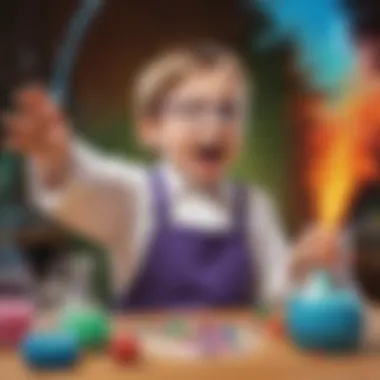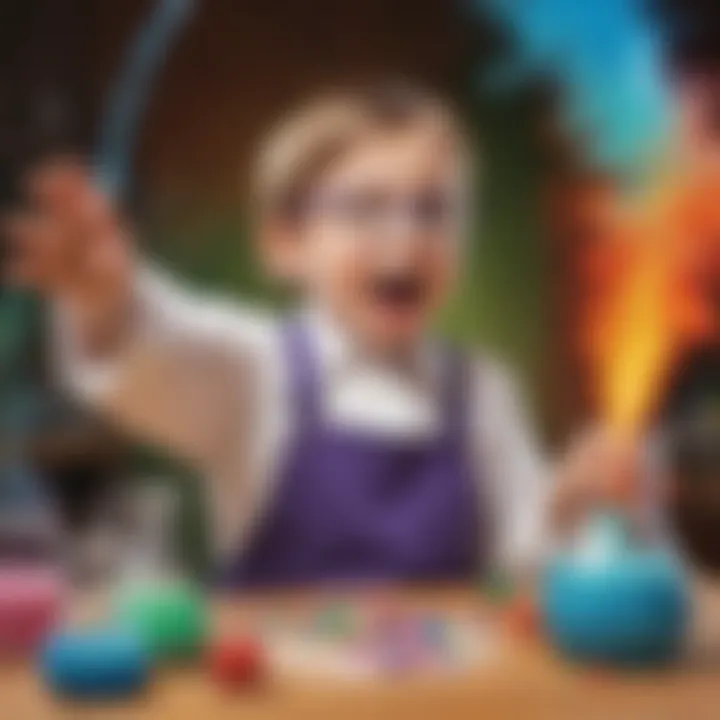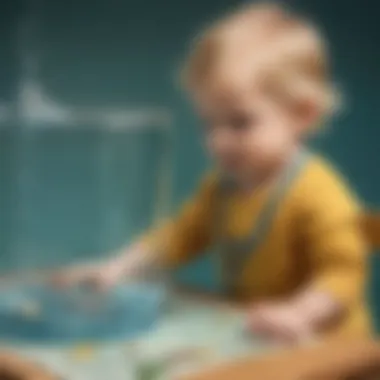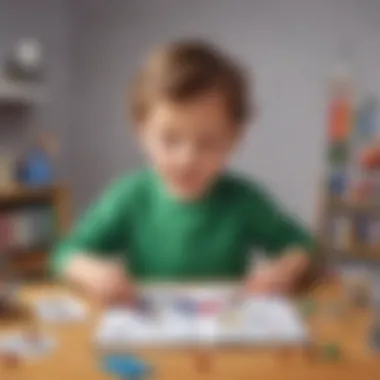Discover the Magic of Science Experiments for 3-Year-Olds


Creative Activities
Scientific exploration at a young age opens doors to endless possibilities. Craft ideas tailored for inquisitive 3-year-olds illuminate the wonders of the scientific world. From simple experiments with water and ice to hands-on projects like making slime, these activities engage young minds in interactive learning experiences that spark curiosity and critical thinking skills. Step-by-step guides provide detailed instructions to assist parents and caregivers in facilitating these experiments, ensuring a smooth and educational journey for budding scientists. Discussing the educational value inherent in these activities emphasizes the cognitive and developmental benefits accrued through engaging in such hands-on learning experiences.
Fun Quizzes
As part of the educational journey, incorporating fun quizzes tailored to young children enhances their grasp of scientific concepts. Quiz topics curated for 3-year-olds revolve around basic scientific principles and everyday observations, making learning enjoyable and captivating. Varied question types, including multiple choice and true or false questions, cater to different learning styles and promote active participation. These quizzes serve as tools for reinforcing knowledge gained through practical experiments, solidifying understanding in a fun and interactive manner.
Fact-Based Articles
Delving further into the world of science for preschoolers, fact-based articles offer a wealth of knowledge in digestible formats. Covering an array of topics spanning from plants and animals to gravity and colors, these articles present information in engaging and easy-to-understand ways. By incorporating visuals, interactive elements, and real-life examples, the articles foster a deeper understanding of scientific concepts among young readers. Moreover, providing additional resources such as links to relevant articles and external sources encourages further exploration and self-directed learning in the realm of science.
Introduction
In this segment, we embark on a captivating journey delving into the realm of science experiments specifically tailored for the curious minds of 3-year-olds. Recognizing the significance of early exposure to scientific exploration, this article aims to shed light on age-appropriate activities that not only foster a love for discovery but also lay the groundwork for a lifelong appreciation of science.
Importance of Early Science Exploration
Development of Curiosity
Embarking on the exploration of the essence of curiosity in the realm of science for young children, we unravel the intricate nuances of how this fundamental trait plays a pivotal role in nurturing a child's inquisitive nature. With a focus on igniting the flame of curiosity within our young learners, we delve into the key characteristics that make the development of curiosity such a foundational aspect of scientific exploration. Exploring the benefits of fostering curiosity from an early age in this context, we dissect the unique features that fuel a child's thirst for knowledge, paving the way for a journey filled with wonder and discovery.
Enhancement of Cognitive Skills
Delving into the realm of enhancing cognitive skills through early science exploration, we uncover the transformative impact of engaging young minds in scientific pursuits. Highlighting the key characteristics that make cognitive skill development an integral part of the learning process for 3-year-olds, we examine why honing these skills is crucial in the context of this article. Diving into the advantages and potential drawbacks of focusing on cognitive skill enhancement in early science exploration, we navigate through the distinctive features that shape a child's cognitive development.
Fostering a Love for Learning
Unraveling the intricate tapestry of fostering a love for learning through science experiments, we illuminate the path towards instilling a deep-seated passion for discovery in young hearts. Shedding light on the key characteristic that makes fostering a love for learning an essential element of early science exploration, we explore why this aspect holds such significance in the world of 3-year-old learners. Examining the unique features that contribute to cultivating a love for learning and the potential advantages or disadvantages of this approach within the context of this article, we embark on a journey towards nurturing a generation captivated by the wonders of science.
Understanding Child Development at Age
Cognitive Milestones
Embarking on a detailed exploration of cognitive milestones in the context of a 3-year-old's development, we unravel the intricate web of cognitive growth during this crucial phase. Highlighting the key characteristics that define cognitive milestones at this age and their relevance to early science exploration, we delve into why understanding these milestones is paramount in catering to a child's learning needs. Exploring the unique features that mark cognitive milestones at age 3 and the potential advantages and disadvantages of focusing on them within the scope of this article, we pave the way for a comprehensive understanding of a child's cognitive journey.


Motor Skills Development
Navigating through the realm of motor skills development in 3-year-olds, we shed light on the crucial role that physical dexterity plays in a child's overall growth and development. Unpacking the key characteristics that define motor skills development and its profound impact on early science exploration, we explore why honing these skills is essential for a holistic learning experience. Delving into the unique features that shape motor skills development at this age and the potential advantages or disadvantages of emphasizing them within the context of this article, we lay the foundation for a well-rounded approach to nurturing young learners.
Attention Span Considerations
Exploring the nuanced landscape of attention span considerations in 3-year-olds, we unravel the intricate dynamics of focus and engagement in young children. Highlighting the key characteristic that defines attention span considerations and its significance in the realm of early science exploration, we dissect why acknowledging and adapting to these considerations is crucial in guiding a child's learning journey. Delving into the unique features that influence attention span at this stage and the potential advantages or disadvantages of addressing them within the framework of this article, we pave the way for a nuanced understanding of fostering optimal learning experiences for young minds.
Choosing the Right Experiments
In this section, we delve into the crucial aspect of selecting the appropriate science experiments for 3-year-olds. The significance of choosing the right experiments lies in the fundamental role it plays in shaping a child's early exposure to scientific exploration. By carefully selecting experiments tailored to a toddler's developmental stage, we can cultivate their innate curiosity and lay a strong foundation for future learning endeavors. Understanding the specific elements that make an experiment suitable for young children is essential in creating an engaging and enriching educational experience.
Safe and Simple Criteria
Non-Toxic Materials
When it comes to conducting experiments with young children, the use of non-toxic materials is paramount. Non-toxic materials ensure the safety of the child as they explore and interact with the experiment. These materials eliminate the risk of harmful exposure, providing peace of mind to parents and caregivers. The key characteristic of non-toxic materials is their harmless nature, making them an ideal choice for experiments designed for 3-year-olds. Their unique feature lies in their ability to stimulate learning without posing any health hazards, aligning perfectly with the educational goals of this article.
Easy Instructions
Clear and straightforward instructions are essential when crafting experiments for toddlers. Easy instructions facilitate hassle-free exploration, allowing young children to engage independently and actively in the learning process. The key characteristic of easy instructions is their simplicity, ensuring that children can follow along with minimal guidance. By providing step-by-step directions that are easy to comprehend, caregivers can enhance the child's understanding of scientific concepts and encourage a sense of accomplishment. While easy instructions streamline the learning experience, they may lack in-depth complexity, requiring a balance between simplicity and educational value.
Minimal Equipment
Minimal equipment requirements are a defining factor in selecting experiments for 3-year-olds. By opting for experiments that necessitate minimal equipment, parents and caregivers can easily set up activities without the need for extensive preparation. The key characteristic of minimal equipment experiments is their accessibility, making science exploration more attainable for young children. This choice is beneficial as it minimizes logistical challenges and focuses on the experiential aspect of the activity. However, the drawback of minimal equipment is the potential limitation in exploring more elaborate scientific concepts that may require additional tools and resources.
Engaging Topics for Toddlers
In this segment, we explore captivating science topics specifically tailored to engage toddlers in the realm of discovery and experimentation.
Color Mixing
Color mixing is a fascinating concept that captivates young children's imagination and creativity. This hands-on activity involves blending primary colors to create new shades, fostering a deeper understanding of color theory. The key characteristic of color mixing experiments is their visual appeal, stimulating sensory perception and artistic expression. This engaging topic opens up avenues for children to explore color harmonies and observe the magic of color transformation, making it a popular choice for science exploration with 3-year-olds.
Sensory Bins
Sensory bins offer a multi-sensory experience that promotes tactile exploration and cognitive development in toddlers. These bins contain various materials like rice, sand, or water, providing diverse textures for children to explore. The key characteristic of sensory bins is their versatility, catering to different sensory preferences and stimulating sensory processing skills. This hands-on activity encourages imaginative play and sensory integration, making it a valuable choice for fostering holistic child development through scientific inquiry.


Water Play
Water play presents a dynamic and interactive experience for young children to engage with scientific concepts such as buoyancy, liquid properties, and water flow. This sensory-rich exploration cultivates an appreciation for the properties of water and encourages scientific investigation through play. The key characteristic of water play is its versatility and adaptability, offering endless possibilities for experimentation and discovery. By integrating water-based activities, caregivers can promote sensory development, cause and effect relationships, and spatial awareness in 3-year-olds, making it a highly beneficial topic for scientific exploration.
Setting Up the Experiment Environment
Setting up the experiment environment for 3-year-olds is a crucial aspect of ensuring a safe and engaging learning experience. By creating a conducive space for exploration, children can develop a keen interest in scientific concepts from a young age. One of the primary considerations when setting up the experiment environment is safety. Ensuring that the materials used are non-toxic and child-friendly is paramount in preventing any accidents or mishaps during the scientific activities. Moreover, a well-organized and visually appealing environment can captivate the attention of toddlers, making the learning process more enjoyable and effective.
Creating a Safe Space
Childproofing Measures
Childproofing measures play a vital role in maintaining a safe environment for young children engaging in scientific experiments. Implementing safety gates, ensuring sharp objects are out of reach, and securing electrical outlets are essential steps in childproofing the experiment area. The key characteristic of childproofing measures lies in their ability to prevent potential hazards and create a secure space for children to explore scientific phenomena. They are a popular choice for this article, given the emphasis on promoting a safe and risk-free learning environment. Despite their advantages, some childproofing measures may limit the freedom of movement for children, balancing safety with exploration is crucial.
Supervision Guidelines
Supervision guidelines are critical in ensuring the well-being of children during science exploration activities. Establishing clear guidelines on adult-to-child ratios, providing constant supervision, and setting boundaries for experimentation contribute to a secure learning environment. The key characteristic of supervision guidelines is their role in overseeing children's actions to prevent accidents and guide learning effectively. Parents and caregivers view supervision guidelines favorably as they offer a structured approach to fostering curiosity and preventing potential dangers. However, excessive supervision may hinder children's independence and problem-solving skills, necessitating a careful balance between guidance and autonomy.
Cleanup Procedures
Efficient cleanup procedures are essential after engaging in science experiments to maintain a tidy and organized space. Teaching children the importance of cleaning up after themselves instills a sense of responsibility and discipline. The key characteristic of cleanup procedures is their role in instilling good habits and respect for the environment. Parents and caregivers appreciate cleanup procedures for their contribution to teaching valuable life skills and reducing clutter. However, overly strict cleanup routines may overshadow the fun aspects of experimentation, underscoring the need for a balanced approach to maintaining cleanliness.
Incorporating Play and Learning
Interactive Setup
Interactive setups in science experiments enhance engagement and facilitate experiential learning for young children. The interactive nature of setups encourages hands-on exploration and promotes sensory experiences. The key characteristic of interactive setups is their ability to stimulate multiple senses, making learning enjoyable and impactful. Parents and caregivers opt for interactive setups as they facilitate active participation and spark curiosity in children. Nevertheless, overly complex interactive setups may overwhelm young learners, necessitating simplicity and clarity in design.
Learning Through Exploration
Encouraging children to learn through exploration fosters a sense of independence and critical thinking. Allowing kids to investigate freely and make discoveries on their own promotes a deeper understanding of scientific principles. The key characteristic of learning through exploration is its role in nurturing a sense of curiosity and self-discovery. Parents and caregivers value this approach for its emphasis on hands-on learning and cognitive development. However, promoting exploration without sufficient guidance may lead to confusion or unsafe experimentation, highlighting the importance of providing structured opportunities for discovery.
Encouraging Questions
Promoting a culture of questioning in science activities helps children develop analytical skills and a thirst for knowledge. Encouraging kids to ask 'why' and 'how' nurtures a sense of inquisitiveness and promotes deeper engagement with scientific concepts. The key characteristic of encouraging questions is its ability to stimulate critical thinking and ignite curiosity. Parents and caregivers see value in fostering questioning behaviors as they lay the foundation for lifelong learning and problem-solving. Nevertheless, an overwhelming focus on questioning may detract from the practical aspects of experimentation, emphasizing the need for a balance between inquiry and application.


Execution and Observation
Science experiments for 3-year-olds involve a crucial phase known as 'Execution and Observation.' This stage is paramount in fostering curiosity and critical thinking skills in young minds. By engaging in hands-on activities, children absorb scientific concepts through tangible experiences. Observing cause-and-effect relationships enhances their understanding of the world around them, laying a foundation for future learning. The execution of experiments instills a sense of exploration and discovery, nurturing a passion for inquiry in young scientists.
Hands-On Participation
Encouraging Touch and Feel
Encouraging touch and feel in science experiments stimulates sensory development in toddlers. By allowing children to explore different textures and materials, they engage their tactile senses, promoting sensory awareness and fine motor skills. Through tactile experiences, children learn about various properties of objects, such as smoothness, roughness, or softness, enhancing their cognitive understanding of the physical world.
Simple Instructions
Providing simple instructions in science experiments for 3-year-olds is essential for their comprehension and engagement. Clear and concise directions help children follow the experimental process efficiently, promoting independence and problem-solving skills. Simple instructions also reduce the likelihood of errors, ensuring a smooth execution of the experiment and fostering a sense of accomplishment in young learners.
Guided Exploration
Guided exploration guides children through the scientific inquiry process, offering support and encouragement along the way. By providing gentle prompts and asking open-ended questions, caregivers promote critical thinking and hypothesis formation in children. Guided exploration enhances the learning experience by bridging the gap between theory and observation, allowing children to connect abstract concepts with real-world phenomena.
Observing Reactions and Patterns
Facilitating Learning Moments
Facilitating learning moments in science experiments aids in consolidating newfound knowledge and concepts. When children observe patterns or unexpected reactions during an experiment, it presents an opportunity for deeper learning and understanding. By discussing these moments with children, caregivers can help reinforce scientific ideas and encourage further exploration and questioning.
Documenting Discoveries
Documenting discoveries in science experiments encourages children to record their observations and findings. Through drawings, notes, or simple reports, children solidify their understanding and retain information better. Documenting discoveries also allows children to reflect on their experiments, fostering a sense of achievement and pride in their scientific endeavors.
Encouraging Imagination
Encouraging imagination in science experiments sparks creativity and innovation in young learners. By prompting children to think beyond the expected outcomes, caregivers inspire them to explore different possibilities and solutions. Engaging children's imaginations fosters a love for experimentation and discovery, paving the way for future scientific exploration and inquiry.
Fostering Curiosity and Inquiry:
Fostering curiosity and inquiry in young minds is a paramount objective in early childhood education. By encouraging children to question, explore, and discover, we lay the foundation for a lifelong love of learning and discovery. In the context of this article, fostering curiosity and inquiry entails creating an environment that stimulates children's natural inclination to inquire and investigate. By posing thought-provoking questions, providing opportunities for hands-on exploration, and nurturing a thirst for knowledge, we can ignite a spark of curiosity that will drive a child's scientific journey. It is crucial to emphasize the importance of open-ended inquiries, allowing children to express their thoughts freely and fostering a sense of wonder and excitement about the world around them.
Encouraging Further Exploration:
Follow-Up Questions: Follow-up questions play a crucial role in reinforcing learning and deepening understanding. By asking thought-provoking questions after an experiment or activity, caregivers can encourage children to reflect on their experiences and draw connections to real-world scenarios. These questions prompt critical thinking, spark curiosity, and invite children to articulate their observations and insights. A key characteristic of follow-up questions is their ability to stimulate dialogue and prompt extended exploration, nurturing a child's innate sense of curiosity and inquiry. While follow-up questions enhance learning outcomes, caregivers must strike a balance between guiding discussions and allowing space for independent reflection. Related Activities: Engaging in related activities post-experiment is a valuable way to expand on discoveries and consolidate learning. These activities can range from creative projects inspired by the experiment to outdoor explorations that connect science concepts to the natural world. By participating in related activities, children can deepen their understanding of scientific principles, apply newfound knowledge in different contexts, and enrich their overall learning experience. One unique feature of related activities is their ability to make learning holistic and interconnected, fostering a multidimensional approach to scientific exploration. Building on Discoveries: Building on discoveries involves taking children's initial observations and inquiries to the next level. Caregivers can encourage children to conduct further experiments, research related topics, or engage in collaborative investigations to deepen their understanding. This process not only reinforces the significance of continuous learning but also empowers children to take ownership of their discoveries. A notable advantage of building on discoveries is its capacity to nurture problem-solving skills, resilience, and a growth mindset in young learners. Through this iterative process of exploration and reflection, children can develop a profound appreciation for the iterative nature of scientific inquiry.
Creating a Science-Friendly Environment:
Integrating Science in Daily Play: Introducing science concepts into everyday play activities seamlessly integrates learning into the child's natural environment. By infusing scientific ideas into playtime, caregivers can make learning enjoyable, accessible, and practical. Whether it's incorporating simple physics concepts into building blocks or exploring concepts of buoyancy during bath time, integrating science into daily play fosters a natural curiosity for the world around us. The key characteristic of this approach is its ability to make learning experiential and relevant, turning ordinary activities into engaging scientific explorations. Incorporating Nature Walks: Nature walks offer a unique opportunity for children to connect with the natural world and observe scientific phenomena firsthand. Whether it's studying plants, observing wildlife, or exploring natural phenomena like erosion, nature walks provide a sensory-rich environment for learning. By immersing children in outdoor experiences, caregivers can ignite a sense of wonder and curiosity about the environment and inspire a passion for conservation. One notable feature of nature walks is their ability to promote physical activity, sensory awareness, and an appreciation for the interconnectedness of living organisms. Reading Science Books: Exploring science books with children opens doors to new ideas, discoveries, and realms of knowledge. By reading age-appropriate science books together, caregivers can stimulate children's imaginations, enhance their vocabulary, and introduce them to scientific concepts in a captivating manner. The unique feature of reading science books lies in their ability to combine storytelling with factual information, making complex topics accessible and engaging for young readers. Through shared reading experiences, children can develop a love for reading and a thirst for knowledge that extends far beyond the pages of a book.







